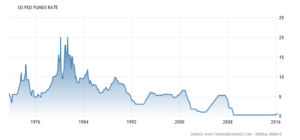The Federal Reserve and Interest Rates
The Federal Reserve controls the three tools of monetary policy — open market operations, the discount rate, and reserve requirements. Using the three tools, the Federal Reserve influences the demand for, and supply of, balances that depository institutions hold at Federal Reserve Banks and in this way alters the federal funds rate.
Changes in the federal funds rate trigger a chain of events that affect other short-term interest rates, foreign exchange rates, long-term interest rates, the amount of money and credit, and, ultimately, a range of economic variables, including employment, output, and prices of goods and services [1].
As shown in the graph below, the federal funds rate has been at .25% from 2009 through the end of 2015, primarily as a result of the 2008 financial crisis and the lingering effects on employment and the economy. At the end of 2015, the federal funds rate target was increased to .50%.
Historical United States Federal Funds Rate

Now is a good time for a Company owner looking for an exit strategy, as federal funds interest rates at historically low levels contribute weight to a seller’s market.
[1] More information on the Federal Reserve can be found at their website, https://www.federalreserve.gov/default.htm



